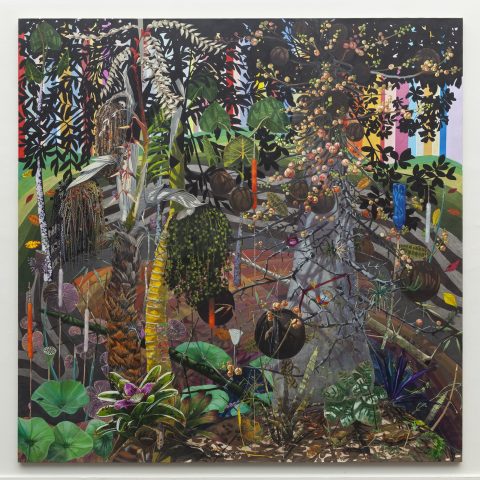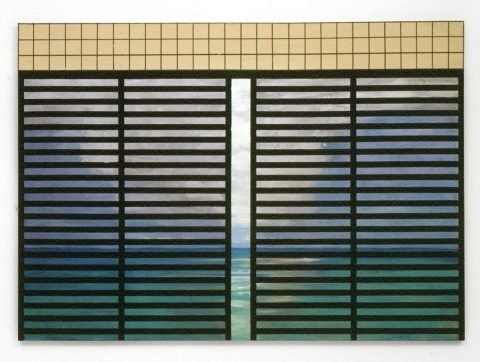A retrospective meeting with Luiz Zerbini
Brazilian polymath artist looks back at his intense creative career and lifetime fascination for waves.
Though Luiz Zerbini is primarily known for his canvases, to label him as a painter would be at least an understatement. Throughout nearly forty years of art practice, he has created sculptures, photos, collages, videos and installations, designed theatre sets, covers for books and discs, acted, composed music and sound pieces as a member of Chelpa Ferro – alongside artists Barrão and Sérgio Mekler – and, more recently, has been engaged in the production of a series of monotypes. ‘I’m a curious guy’, he tell us, ‘always in need of new stuff, encouragement. I’m a quiet person, but my work is restless, it has to be. That’s why I take so many chances, and make some mistakes every now and then’.
- Luiz Zerbini in his studio, photographer Nana Moraes.
- Luiz Zerbini, Lago Quadrado, 2010 Acrilyc on canvas 294 x 292 cm. Courtesy of Inhotim Foundation.
- Luiz Zerbini, Mar do Japao, 2010 Acrilyc on canvas 290 x 393 cm.
- Luiz Zerbini, Untitled, 2003. Acrylic on canvas 100 x .140 cm.
Though Luiz Zerbini is primarily known for his canvases, to label him as a painter would be at least an understatement. Throughout nearly forty years of art practice, he has created sculptures, photos, collages, videos and installations, designed theatre sets, covers for books and discs, acted, composed music and sound pieces as a member of Chelpa Ferro – alongside artists Barrão and Sérgio Mekler – and, more recently, has been engaged in the production of a series of monotypes. ‘I’m a curious guy’, he tell us, ‘always in need of new stuff, encouragement. I’m a quiet person, but my work is restless, it has to be. That’s why I take so many chances, and make some mistakes every now and then’.
Such curiosity can be perceived in the artist’s eyes, whose liveliness effortlessly deceit his age. Born in Sao Paulo in 1959, Luiz Zerbini began his apprenticeship as a painter with José Antônio Van Acker in 1973, at the same time he took on photography lessons with Carlos Moreira. While still a teenager, he lived for a year in the coastal city of Laguna, in the southern state of Santa Catarina, where he would spend most of his time surfing. Perhaps unbeknown to the artist then, this experience would decisively shape his subsequent practice, as his enduring passion for waves is recurrently evidenced in his compositions. In 1978 Luiz Zerbini enrolled at the prestigious Fine Arts programme of FAAP (Fundação Armando Álvares Penteado) in his hometown; though his studies were often interrupted by long trips, and were eventually left unfinished, it was during this period that he started to establish his artistic circle. ‘I believe that the evolution of art as a whole comes largely from an artist pushing another forward – copying or not, but there is a certain promiscuity. And I believe that’s a good thing’. Indeed, Luiz Zerbini carries a reputation among his peers of being extremely generous when sharing thoughts on their work.
As of many artists of his generation, his career’s breakthrough came with the 1984 exhibition Como vai você, geração 80? (How Are You, 80s Generation?) at Rio de Janeiro’s Parque Lage. Emphasising a renewed interest in painting advocated by young artists at that time, the show presented the work of 123 practitioners, including Beatriz Milhazes and Leda Catunda – namely some of the finest contemporary artists from Brazil today. By then, Luiz Zerbini had established himself permanently in Rio – a landscape that, as of the waves and with its waves, mountains and nature, has also recurrently inspired his canvases. He then gradually started to attract the attention of galleries, curators, museums and collectors; invitations for solo and group shows followed.
His paintings at that time were rather figurative, portraying curious landscapes or dreamlike city scenes, commonly with the presence of human figures. The sober palette that characterised his production in the mid 1980s slowly gave way to a brighter, highly colourful one. Exotic plants, abundant within Rio’s atlantic forrest, increasingly became the protagonists of his compositions. The human figures that at times would also populate the canvases were now often that of his friends, adding a layer of affection to the works; some of them were in fact closer to portraiture than to landscape. Luiz Zerbini also took on an interest in still-life, though an inaccurate scale between the real fruits and their pictorial counterparts would sustain a certain surrealism that’s signature of his art (broadly speaking, the artist has a taste for immersive formats). Some of the most compelling paintings from this period, as critic Agnaldo Farias points out (Luiz Zerbini ARTE BRA. Various authors. Editora Aeroplano, Rio de Janeiro, 2010. P 40), are the ones where Zerbini gathers the three above mentioned genres of painting – landscape, portraiture, still-life – within a single composition, as in Contemporary Hamlet Doesn’t Hold the Little Skull and Indian (both 1994) or I Landscape (1998).
Luiz Zerbini’s persistent curiosity eventually led him to a significant shift. Towards the late 1990s, his colourful canvases became increasingly abstract and, above all, geometric. His 1999 exhibition at Galeria Camargo Vilaça (now Fortes d’Aloia & Gabriel) in Sao Paulo, titled Stone is Not People Yet, presented a series of paintings employing the ancient Chinese marbling technique; that was the first time the artist exhibited an entirely abstract body of work. On this shift, he comments, ‘abstraction has always accompanied me, since the beginning. Few years ago my mother sent me a box she found at her home that contained my final work for FAAP. It was a tridimensional sculpture, all modular, in cubes and squares. When I saw that – later I sort of transformed it into a work called Artist’s DNA – but when I saw that, I was so surprised, and thought to myself, “it is as if I was doing this already then, as if one day I would eventually arrive at this point. That’s the path I’m heading towards”. The abstract, geometric side was much less evident throughout a period of my career, but it was never entirely absent’. Neither waves were absent during his abstract years, often finding their way into the canvases, even if as sound waves.
The making of his book Rasura (meaning something between ‘obliteration’ and ‘blot’), in 2005, is perceived by Luiz Zerbini as another watershed moment within his artistic process, one that made him rethink his whole oeuvre. Far from being a publication surveying his practice, it contains images of works by other artists that are dear to Zerbini, some of his paintings, fragments from magazines and books and, except for some excerpts and annotations of his own, no texts at all. With Rasura, he generously invites the viewer to enter his universe of references, acquaint themselves with his vocabulary. The artist draws a parallel between the way his memory works and the crystal easels designed by Lina Bo Bardi for MASP (Museu de Arte de Sao Paulo), which allow the visitor to see several works at once depending on where they place themselves in the room; Rasura is perhaps Zerbini’s attempt to share this super-perspective with others.
His path towards abstraction found its peak in 2007 with a work bearing the emblematic title My Last Painting. Measuring 270 x 420 cm, it consists of a canvas painted with a metallic, shiny material that, as of a distorted mirror, reflects whatever object or figure is placed in front of it. Here again, through a completely different strategy, Luiz Zerbini embodies notions of portraiture, landscape and still-life within one composition; it all comes down to the surrounding environment. He wrote of this work:
‘It’s interdisciplinary and contradictory
It’s cinema and theatre
It’s scene and scenery
It’s painting in movement
It rests the eyes
It’s the proof that blue comes from black
and not the other way around
It’s subtle and imperceptible
I’ve done it,
Sorry, it’s incontestable.’ (Luiz Zerbini ARTE BRA, 2010. P 134)
In recent years, figuration became once again the main trait of Luiz Zerbini’s paintings. The wild, quasi-surreal vegetation that inhabited his work during the 1990s re-emerged in an even more majestic, vibrant manner. In this new body of work, they negotiate the canvas with geometric patterns – a wall or table, a grid pacing the rhythm of the composition, small details. Yet, what’s truly unique about them is how the artist manages to imprint a geometric quality to the unruled flora while keeping it deeply wild and, at the same time, make the geometry gracious, relaxed. Like a filmmaker who masters the narrative structures of both fiction and documentary – and there are so few – Luiz Zerbini grasped with precision the distinct languages of figuration and abstraction, and blends them like no one else. Human figures, however, have totally left his newest compositions; at least for the moment.
Using always acrylic paint – which dries much faster than oil – Luiz Zerbini’s paintings are composed by several layers, as he repeatedly adds new elements to his compositions, covering others. He states that he likes painting while looking at his subjects the most – ‘there is a particular connection, a unique tempo’ – but also paints from memory and photos. Since August 2016, he has relocated to a much bigger studio in the Gávea neighbourhood, where he keeps a garden with his favourite plants in the backyard. Since the objects that are present in his compositions are painted individually, they are never all together at once but in the paintings. He tell us that he keeps most of the things he paints, and would one day like to do an exhibition clustering all the elements that are present in each of the paintings in from of them, thus inverting its logic. For the moment, he continues to work on the monotypes – ‘it’s just the beginning, there is much yet to come’ – trying to adjust the technique to print images straight on the canvases, while permanently indulging his curiosity. ’Everything inspires me, all the time’, he tell us, ‘I am inspired. I guess that what inspires me is the act of looking, I understand all things through my eyes. And I enjoy to be surprised’.
November 20, 2019




